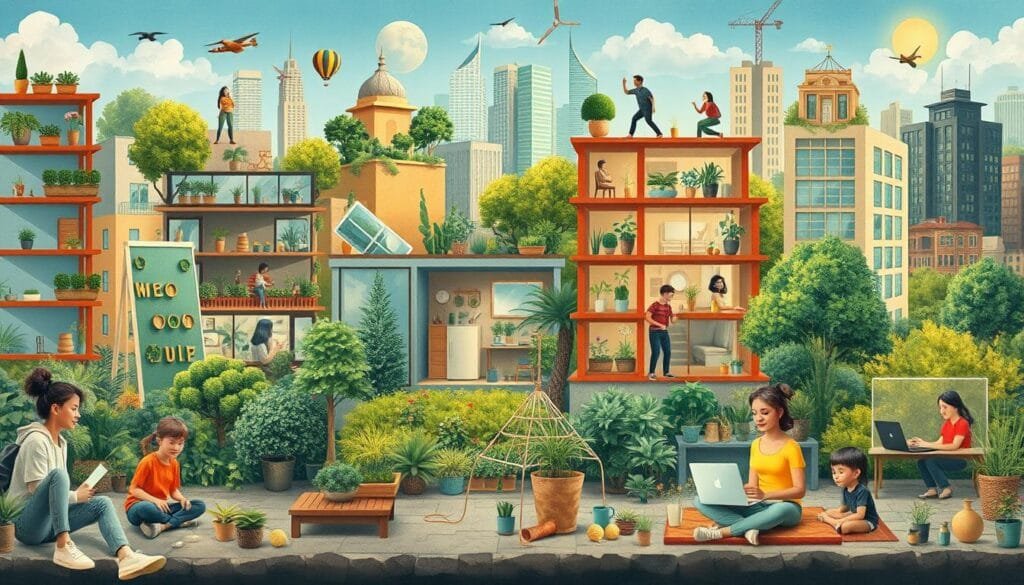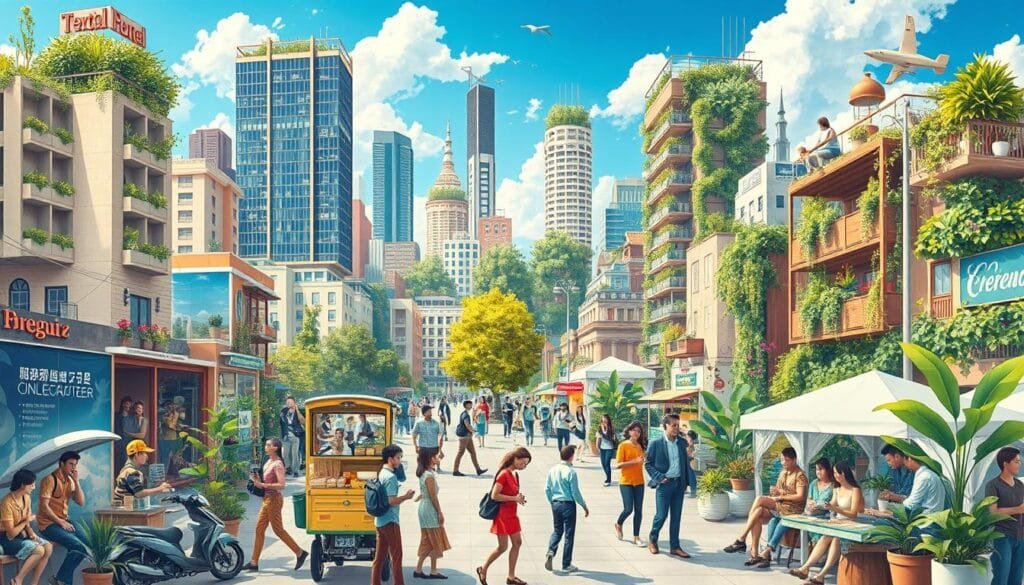Our world is quickly changing, with big shifts shaping how we live. Think of those huge trends that span years or even decades. They touch everything from what we wear to the gadgets we use and how businesses operate. This journey will look into how the digital world’s growth and a focus on sustainability are changing what people expect and how companies plan for the future.
Take 2024, for example. It’s predicted to be big for tech that makes experiences better, like artificial intelligence (AI) and social media. Around 41% of folks think AI will help suggest products they’ll like. About 46% believe it’ll help them find better deals. Personal touches matter too, with McKinsey & Company finding that 71% of shoppers want it and get upset when it’s missing.
It’s crucial to understand these big lifestyle trends and their impact on society. For anyone looking to keep up, whether you’re shopping or running a business, this guide is for you. It’s packed with the knowledge you need to succeed in a world that keeps changing.
Key Takeaways
- Macro lifestyle trends are long-term cultural and societal shifts impacting various industries.
- Digital innovations like AI and social media are key drivers of these trends.
- 71% of consumers expect personalization, with significant frustration when it’s absent.
- By 2028, social media is expected to reach nearly 331 million global users.
- McKinsey & Company reports 76% of consumers desire relevant recommendations on first interaction.
- AI and personalization are reshaping consumer behavior and expectations.
Understanding Macro Lifestyle Trends
The Definition and Scope of Macro Trends show they are big movements. They touch everything from tech to how we shop, lasting many years. As they change, they shape our society, guiding cultures and everyday decisions.
To get what macro trends mean, look at the push for being green. This move has more people wanting products that don’t hurt the planet. It shows we’re becoming more aware of environmental issues, aiming for a greener tomorrow.
Digital advances are key too, changing sectors with breakthroughs like AI and virtual reality. These changes are redoing how companies work and how we interact with brands.
These trends also deeply affect culture as we adjust to new standards and priorities. Take fashion, where digital tools like virtual try-ons are getting popular. This shows how tech blends into our lifestyle choices. Hence, fashion doesn’t just follow but also influences our society.
Knowing these trends help us foresee changes in global consumer habits. In fashion, the growth of Quiet Luxury and phygital stores points to a love for quality and interactive shopping. These trends impact much more than just fashion.
| Trend Type | Characteristics | Examples |
|---|---|---|
| Macro Trends | Long-term, widespread influence | Sustainability, Digital Innovation |
| Micro Trends | Short-term, niche-specific | Tie-Dye Patterns, Athleisure |
| Nano Trends | Highly specific, hyper-localized | Micro Bags, Cottagecore |
By recognizing and adapting to these trends, we better understand the changing world. This helps us make choices that reflect bigger cultural shifts and values.
What’s Driving These Trends?

Many factors drive the big changes in how we live today. *Technology and Innovation* are at the forefront. They bring new ways to connect and do business. Advances like artificial intelligence and the Internet of Things are changing everything.
Environmental concerns are pushing companies towards sustainability in business. Research shows people worry most about the planet, then their health. This isn’t just a trend. It’s a major shift in how we choose what we buy. Products that are natural and less processed are becoming more popular.
For example, the food industry is looking for healthier options. People want foods that help them manage weight and reduce sugar and salt. This means more natural ingredients are in demand. Businesses are noticing this and changing what they offer.
Personalized on-demand services are also getting big. Digital tools let us get what we want, how we want it. This is true in many areas, like eating out or traveling. The interest in #vanlife has shot up, showing people want different ways to live. High house prices are one reason for this.
The cost of living is going up, and young people are opting out of the 9-5 life. Meanwhile, Boomers, who are less affected by recessions, spend big on luxury travel. They don’t worry as much about budgeting as younger folks do, especially when planning trips.
In summary, *technology trends*, sustainability, and changing tastes are all shaping our lifestyles. Keeping up with these shifts is key for businesses and shoppers. It helps everyone adapt and succeed in a world that keeps changing.
What Are the Different Macro Lifestyle Trends
Today, it’s key to grasp the major trends changing our way of living. These trends impact industries deeply and alter how we behave as consumers. They have big effects on both our personal lives and the economy.
Digital Transformation
Digital transformation stands out among current trends, reshaping our interactions, work, and use of services. It leads to more gig and remote jobs, offering flexibility and new ways to earn. This change stems from tech advances and more access to fast internet.

Health and wellness have become more important than before. In the hospitality sector, 80% of guests now work on their health daily. They look for personalized wellness and eco-friendly options, even if it costs more. This shift shows people are taking their health more seriously these days.
| Macro Trends | Key Insights | Impact on Industries |
|---|---|---|
| Digital Transformation | Shift towards remote work and digital engagement | Technology, Hospitality, Employment |
| Health and Wellness | Guests take steps for well-being; higher spend on wellness | Hospitality, Consumer Goods, Healthcare |
| Eco-Friendly Practices | Willingness to pay more for sustainability | Tourism, Fashion, Retail |
| Culinary Autonomy | Investment in gourmet home ingredients | Food and Beverage, Retail |
Eco-Friendly Practices
Sustainability has become a crucial lifestyle trend. People are okay paying 11 to 20% extra for eco-friendly services in hospitality. This reflects a wider move towards sustainability in buying behavior, affecting tourism, fashion, and retail industries.
Culinary Autonomy
Another big trend is culinary autonomy. People are buying gourmet ingredients for better home cooking. This shows a deeper connection to food sources and a growing self-reliance in cooking, influenced by these larger lifestyle trends.
Grasping these trends and their effects is vital for staying in tune with our rapidly changing world.
Adapting to Macro Trends in Everyday Life
Adapting to big trends means changing our approach to life. We see shifts, like more people moving to the South and West. Also, the middle class shrank from 61% in 1971 to 50% in 2015. These changes affect where we live, work, and handle money.
Being informed and adaptable helps us deal with changes. We follow reliable sources to grasp new patterns. For instance, businesses now focus on helping their communities, reflecting stakeholder capitalism’s rise.

Our daily choices show we’re adjusting to these big trends. Digital groups create unique global communities. This helps us feel connected in a fast-changing world.
Similarly, the fashion world is turning sustainable. They use natural stuff like algae and recycle old clothes. This shows our culture is leaning towards being adaptable.
To handle these big trends, we need to tailor our reactions. Being adaptable and flexible improves our lives and careers. Quick adaptability is now a key skill in this fast-paced world.
In conclusion, personalizing our approach and staying informed helps us. It prepares us to navigate big trends. Using flexible strategies, we can thrive in future changes.
Business Implications of Macro Trends
Understanding macro trends is essential for businesses to stay ahead. Trend forecasting for businesses is key to predict consumer needs and market changes. This helps in adjusting products and strategies accordingly.
Looking at economic signs like GDP, inflation, and job stats guides strategy setting. Tools like PEST analysis offer deep insights into political, economic, social, and technological factors. The Intero Digital blog discusses this in detail.
Also, a SWOT analysis reveals internal strengths such as skilled workers and unique technologies. This helps companies play to their strengths effectively.
It’s vital for businesses to adapt to changes caused by macro trends. Agile methodologies in business allow quick reactions to shifts. A Nielsen Survey in 2023 shows more consumers prefer buying from responsible companies. This highlights the need for social and environmental awareness.
Adopting strategic adaptation is crucial for growth. Companies must consider both small and large-scale factors that affect success. Ignoring customer needs or service quality can result in big losses.
The World Economic Forum suggests diversified companies are more resilient. By knowing the macro environment and using proper forecasting, businesses can make smart decisions. Strategies like SWOT analysis and staying agile help in finding innovative solutions. This is crucial in a competitive market for continuous growth.
Understanding that consumer spending relates to economic confidence is key. The World Economic Forum points out its significance. With good business forecasting, companies can overcome economic challenges and stay competitive.
Future Outlook: What’s Next?
Looking ahead, it’s important to explore the future trends predictions shaping our lives. The growth of AI stands out as a major trend. It’s changing not just tech, but how we live every day. AI is everywhere, from our homes to healthcare, making things smarter and more efficient. This goes hand in hand with the development of smart cities, designed for better living.
Young people today are more aware of issues like corruption and equality. This reflects in upcoming lifestyle changes, leaning towards social responsibility. According to Innova, there’s less trust in governments and big brands. People now demand transparency and authenticity in the market.
The wellness industry is booming and is worth $1.8 trillion. It’s growing quickly, by 5 to 10% each year. With obesity rates climbing, the need for weight management is more crucial than ever.
After the pandemic, there’s a shift towards healthier living. Mental and emotional health are key focus areas. People are seeking real connections and experiences that are truly impactful. This influences market evolution analysis.
Today’s consumers prioritize investment in experiences that provide emotional uplift, such as spending time with loved ones and enjoying holidays.
Emerging markets are ahead in wellness spending, compared to developed ones. The rich, aging population in these areas plan to spend more on fun, showing how future trends predictions are shifting.
| Region | Expected Increase in Wellness Spending |
|---|---|
| Emerging Markets | 2-3 times higher than advanced markets |
| Europe | 7% |
| United States | 11% |
Social commerce could hit $145 billion by 2027 in the U.S., with Gen Z and millennials leading the change. Keeping up with these upcoming lifestyle changes and market evolution analysis is key to success in the years ahead.
Conclusion
As we wrap up our journey, understanding and adapting to macro lifestyle trends becomes crucial for our success. We see how technology, sustainability, and social equality have shaped consumer behavior. Remarkably, consumer spending contributed to 54% of the U.S. GDP in mid-2021. This shows the power of trends on the economy.
Technology is a major force changing our lives. Smart homes and artificial intelligence are examples of how it changes the way we live and interact. Health and wellness are also key trends. They gain importance as healthcare costs rise and the population ages. This highlights the focus on staying mentally and physically healthy.
We also need to consider the economy, looking at inflation, employment, and GDP. The Federal Reserve’s policies on interest rates affect our market strategies. By keeping an eye on these factors, businesses and individuals can align their plans to succeed in this evolving landscape.
In conclusion, staying informed and adaptable to trends is essential. It’s not just important, it’s necessary for staying ahead in a fast-changing world. Let’s keep learning and adjusting our strategies to make the most of these global trends.
FAQ
What are macro lifestyle trends?
Macro lifestyle trends are big changes that affect culture and society over a long time. They last for many years, sometimes decades. These trends have a big impact on different industries, not just fashion. They change how society acts through design changes in lines, textures, lengths, and patterns.
How do macro trends impact consumer behavior?
Macro trends change our society by influencing how people interact, consume, and see the world. For example, the trend of sustainability leads to a higher demand for eco-friendly products. Digital innovations, like AI and virtual realities, are changing how consumers interact with businesses. This shows how wide the effect of these trends can be on cultures and societies.
What drives macro lifestyle trends?
Technology and innovation are big drivers of macro trends. They create new ways of living. Environmental concerns make industries use sustainable practices because people want products made responsibly. Also, digital connectivity and easy access to information make industries offer more personal and on-demand services.
What are some current macro lifestyle trends?
Current trends include digital transformation and focusing more on health and wellness. There’s also a shift towards gig and remote work. These trends are changing how we live and work on a global scale.
How can individuals adapt to macro lifestyle trends?
To adapt, people need to see how these trends impact their life and then adjust. It’s important to stay informed with reliable sources and be ready for fast changes. This can help you grow personally and professionally.
Why is it important for businesses to understand macro trends?
Businesses need to know about macro trends to stay ahead. By forecasting trends, they can meet consumer needs and adapt to market changes. Being agile and ready to change quickly is key. This helps businesses to stay relevant and grow.
What are potential future macro lifestyle trends?
Future trends could include more AI in our lives, the development of smart cities, and advances in biotechnology. These trends might lead to big changes in society, offering chances for people and businesses to prepare and benefit.
